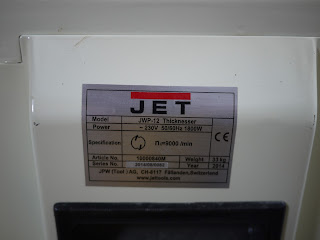Table
To go with the chairs I made:
I needed a table. After a few weeks of work I have finished it. The table and chairs project is finally over. It's taken a while. The chairs are made from scaffolding boards, and so is the table. they are both stained in Osmo wood wax stain (Walnut 3166, I think).
The table is built around a frame:
The frame is put together with pocket hole screws. (I tried a cheap pocket hole jig and all I can say about it is that I immediately bought a more expensive Kreg jig after trying to use it).
The entire frame could be dismantled as it is totally screwed together (with about £50 worth of stainless Kreg screws). The legs are bolted on.
To get chunky square legs I glued several pieces of board together after running them through the thicknesser:
The final legs are about 100mm square:
I put storage into anything I make that can have it, so the table has four drawers inside it:
The drawers are on full extension push-to-open, push-to-close runners:
I used a cheaper brand of runners that I have used before and they are OK, but not great. If I have troubles with the drawer opening action and I get irritated enough with it, I may have a look at replacing them with better quality (i.e. more expensive) ones.
The table top is made from the flattest planks I could find, run through the thicknesser to get them smoother than in their raw form, and then biscuit jointed:
and glued together.
I selected the best side, which would become the top, then hand flattened that side using a hand plane. It came out pretty well, and didn't take too long, surprisingly, perhaps two hours.
The top is fixed to the frame using 3D printed 'buttons', similar to traditional wooden buttons, except the slot is also 3D printed. I was going to use the biscuit jointed to cut the slots, but that wasn't possible as I couldn't get it into some spaces in the frame and I didn't want to dismantle the frame to do it. The buttons and slots are pairs of 3D prints:
Some of the buttons and slots have easter eggs on them for anyone who wants to wander around under the table. There's eight of these button/slot combinations holding the top on and I could add more if I need to. There's also four smaller slotted combination mounting pieces next to the middle of all four drawers which stops that part of the frame from sagging. It is necessary as I cut part of the frame away to allow the drawers to slide in and out.
The side rails of the frame were cut out using a scroll saw and the cut out piece became the drawer front for each of the four drawers. So the front of the drawers match the rails that they slide into.
The final table, with the set of chairs that I made:





























































